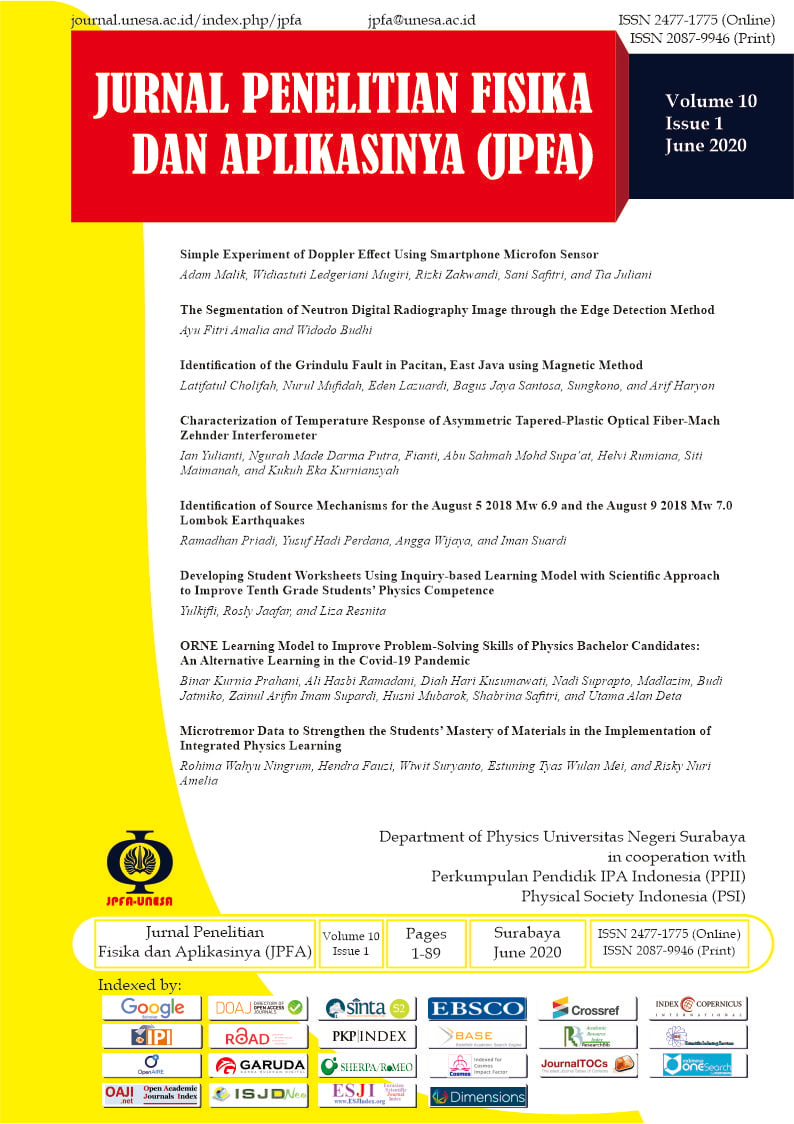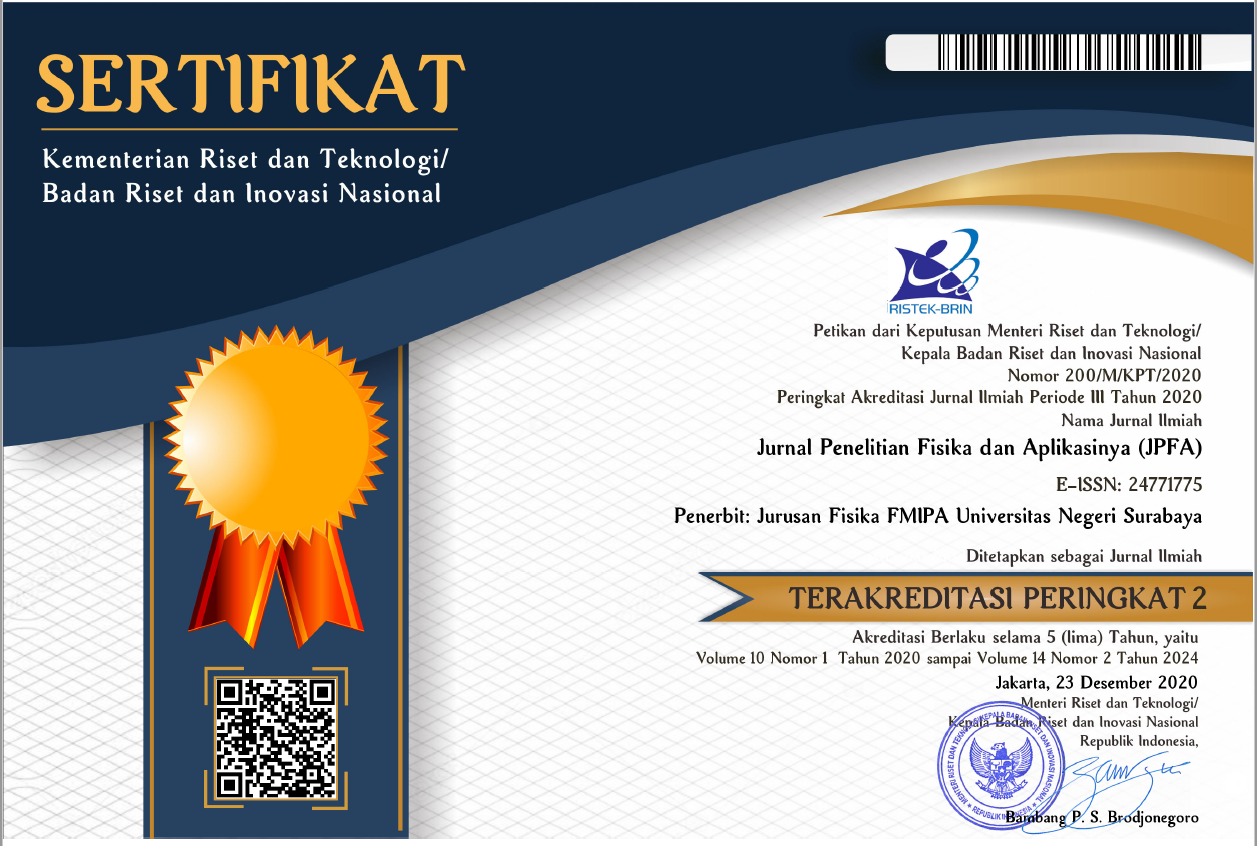Identification of Source Mechanisms for the August 5 2018 Mw 6.9 and the August 9 2018 Mw7.0 Lombok Earthquakes
DOI:
https://doi.org/10.26740/jpfa.v10n1.p44-55Keywords:
slip distribution, asperity, focal mechanismAbstract
A series of earthquakes with magnitudes ranging from 5.8 to 7.0 occurred in Lombok in the period of July to August 2018. Two events occurred consecutively, the 6.9 on August 5, 2018 (11:46:38 UTC), and the 7.0 on August 9, 2018 (14:56:28 UTC). Those phenomena are rare because earthquakes usually require a relatively long time to accumulate their energies before being released. Because of those events, so an explanation is needed to explain what happened at the source. In this context, this study aims to determine the relations between the events based on the asperity zone and the slip distributions. Modeling was performed using teleseismic data and seismic inversion of body waves at low frequencies. The result shows that the asperity zone of 6.9 is at 0 km in a strike-direction and -18 km wide in a dip-direction with a maximum slip of 1.3 m, whereas, for the 7.0 event, the asperity zone is at -36 km in the direction of the strike and -7 km in the direction of the dip. Both events have the asperity in the up-dip section with an upward slip distribution towards the up-dip. The slip distribution of the first event and the second one has a relationship because the 6.9 earthquake slip leads to the 7.0 earthquake fault plane. The relation is suspected to be due to the weakening of rock conditions and an enlargement that is limited by space and time during the earthquake. As a result, those two earthquakes are closely related to stress distribution, forming a new asperity zone.
References
Silver EA, Breen NA, Prasetyo H and Hussong DM. Multibeam Study of the Flores Backarc Thrust Belt, Indonesia. Journal of Geophysical Research: Solid Earth. 1986; 91(B3): 34893500. DOI: https://doi.org/10.1029/JB091iB03p03489.
Yamanaka Y and Kikuchi M. Asperity Map along the Subduction Zone in Northeastern Japan Inferred from Regional Seismic Data. Journal of Geophysical Research: Solid Earth. 2004; 109(B7). DOI: https://doi.org/10.1029/2003JB002683.
Kikuchi M, Kanamori H and Satake K. Source Complexity of the 1988 Armenian Earthquake: Evidence for a Slow Afterslip Event. Journal of Geophysical Research: Solid Earth. 1993; 98(B9): 1579715808. DOI: https://doi.org/10.1029/93JB01568.
Yamanaka Y and Kikuchi M. Source Process of the Recurrent Tokachi-Oki Earthquake on September 26, 2003, Inferred from Teleseismic Body Waves. Earth, Planets and Space. 2003; 55(12): e21e24. DOI: https://doi.org/10.1186/BF03352479.
Dahm T and Kruger F. Moment Tensor Inversion and Moment Tensor Interpretation. Bormann, P. (Ed.), New Manual of Seismological Observatory Practice. (NMSOP-2). Potsdam: Deutsches GeoForschungsZentrum GFZ; 2014: 137. DOI: https://doi.org/10.2312/GFZ.NMSOP-2_IS_3.9.
Suardi I, Yagi Y, Widiyantoro S and Meilano I. Analysis of Source Rupture Process of the September 2, 2009 Tasikmalaya Earthquake by using the Joint Inversion Method of Near Field and Teleseismic Data. Bandung: Study Program of Earth Sciences, Institut Teknologi Bandung; 2013.
Kikuchi M and Kanamori H. Inversion of Complex Body Waves-III. Bulletin of the Seismological Society of America. 1991; 81(6): 23352350. Available from: https://pubs.geoscienceworld.org/ssa/bssa/article-abstract/81/6/2335/102472.
Perfettini H, Frank WB, Marsan D and Bouchon M. A Model of Aftershock Migration Driven by Afterslip. Geophysical Research Letters. 2018; 45(5): 22832293. DOI: https://doi.org/10.1002/2017GL076287.
Kikuchi M, Nakamura M and Yoshikawa K. Source Rupture Processes of the 1944 Tonankai Earthquake and the 1945 Mikawa Earthquake Derived from Low-Gain Seismograms. Earth, Planets and Space. 2003; 55: 159172. DOI: https://doi.org/10.1186/BF03351745.
Delouis B and Legrand D. Mw 7.8 Tarapaca Intermediate Depth Earthquake of 13 June 2005 (Northern Chile): Fault Plane Identification and Slip Distribution by Waveform Inversion. Geophysical Research Letters. 2007; 34(1): L01304. DOI: https://doi.org/10.1029/2006GL028193.
Liu C, Zheng Y, Xie Z and Xiong X. Rupture Features of the 2016 Mw 6.2 Norcia Earthquake and Its Possible Relationship with Strong Seismic Hazards. Geophysical Research Letters. 2017; 44(3): 13201328. DOI: https://doi.org/10.1002/2016GL071958.
Udias A. Development of Fault Plane Studies for the Mechanism of Earthquakes. Observatory Seismology: A Centennial Symposium for the Berkeley Seismographic Stations First Edition. California; 2018: 243356.
Yagi Y, Mikumo T, Pacheco J and Reyes G. Source Rupture Process of the Tecomán, Colima, Mexico Earthquake of 22 January 2003, Determined by Joint Inversion of Teleseismic Body-Wave and Near-Source Data. Bulletin of the Seismological Society of America. 2004; 94(5): 17951807. DOI: https://doi.org/10.1785/012003095.
Lay T and Wallace TC. Modern Global Seismology. San Diego: Acaddemic Press; 1995. Available from: https://www.elsevier.com/books/modern-global-seismology/lay/978-0-12-732870-6.
Zahradnik J, Gallovic F, Sokos E, Serpetsidaki A, and Tseletis A. Quick Fault-Plane Identification by a Geometrical Method: Application to the Mw 6.2 Leonidio Earthquake, 6 January 2008, Greece. Seismological Research Letters. 2008; 79(5): 653662. DOI: https://doi.org/10.1785/gssrl.79.5.653.
Kasmolan M, Santosa B, Lees J and Utama W. Earthquake Source Parameters at the Sumatran Fault Zone: Identification of the Activated Fault Plane. Open Geosciences. 2010; 2(4): 455474. DOI: https://doi.org/10.2478/v10085-010-0016-5.
Sianipar DSJ and Serhalawan YR. Pemodelan Mekanisme Sumber Gempa Bumi Ransiki 2012 Berkekuatan Mw 6,7. JST (Jurnal Sains dan Teknologi). 2017; 6(1): 148-157. DOI: http://dx.doi.org/10.23887/jst-undiksha.v6i1.9333.
Clayton RW and Wiggins RA. Source Shape Estimation and Deconvolution of Teleseismic Bodywaves. Geophysical Journal International. 1976; 47(1): 151177. DOI: https://doi.org/10.1111/j.1365-246X.1976.tb01267.x.
Kikuchi M and Kanamori H. Inversion of Complex Body Waves-II. Physics of the Earth and Planetary Interiors. 1986; 43(3): 205222. DOI: https://doi.org/10.1016/0031-9201(86)90048-8.
Bormann P. New Manual of Seismological Observatory Practice (NMSOP) Vol. 1-2. Potsdam, Boulder: GeoForschungsZentrum Potsdam, IASPEI; 2002. Available from: https://gfzpublic.gfz-potsdam.de/pubman/item/item_229557.
Song F and Toksöz MN. Full-Waveform Based Complete Moment Tensor Inversion and Source Parameter Estimation from Downhole Microseismic Data for Hydrofracture Monitoring. Geophysics. 2011; 76(6): WC103WC116. DOI: https://doi.org/10.1190/geo2011-0027.1.
Meehan T. Evolution of the Propagator Matrix Method and Its Implementation in Seismology. arXiv Geophysics. 2018; 1-12. Available from: https://arxiv.org/abs/1801.04635.
Kikuchi M and Kanamori H. Inversion of Complex Body Waves. Bulletin of the Seismological Society of America. 1982; 72(2): 491506. Available from: https://pubs.geoscienceworld.org/ssa/bssa/article-abstract/72/2/491/118251.
Kikuchi M and Kanamori H. Rupture Process of the Kobe, Japan, Earthquake of Jan. 17, 1995, Determined from Teleseismic Body Waves. Journal of Physics of the Earth. 1996; 44(5): 429436. DOI: https://doi.org/10.4294/jpe1952.44.429.
Ide S. 4.09-Slip Inversion. In Schubert, Treatise on Geophysics, 2nd Edition. Oxford: Elsevier; 2015: 215241. Available from: https://www.elsevier.com/books/treatise-on-geophysics/schubert/978-0-444-53802-4.
Gephart JW. Stress and the Direction of Slip on Fault Planes. Tectonics. 1990; 9(4): 845858. DOI: https://doi.org/10.1029/TC009i004p00845.
Gusman AR, Satake K and Harada T. Rupture Process of the 2016 Wharton Basin Strikeslip Faulting Earthquake Estimated from Joint Inversion of Teleseismic and Tsunami Waveforms. Geophysical Research Letters. 2017; 44(9): 40824089. DOI: https://doi.org/10.1002/2017GL073611.
Shimizu K, Yagi Y, Okuwaki R and Fukahata Y. Development of an Inversion Method to Extract Information on Fault Geometry from Teleseismic Data. Geophysical Journal International. 2020; 220(2): 10551065. DOI : https://doi.org/10.1093/gji/ggz496.
Yoshimoto M and Yamanaka Y. Teleseismic Inversion of the 2004 Sumatra-Andaman Earthquake Rupture Process Using Complete Greens Functions. Earth, Planets and Space. 2014; 66: 152. DOI: https://doi.org/10.1186/s40623-014-0152-4.
Clayton BS, Hartzell SH, Moschetti MP and Minson SE. Finitefault Bayesian Inversion of Teleseismic Body Waves. Bulletin of the Seismological Society of America. 2017; 107(3): 15261544. DOI: https://doi.org/10.1785/0120160268.
He X and Ni S. Rapid Rupture Directivity Determination of Moderate Dipslip Earthquakes with Teleseismic Body Waves Assuming Reduced Finite Source Approximation. Journal of Geophysical Research: Solid Earth. 2017; 122(7): 53445368. DOI: https://doi.org/10.1002/2016JB013924.
Yagi Y, Okuwaki R, Enescu B, Kasahara A, Miykawa A, and Otsubo M. Rupture Process of the 2016 Kumamoto Earthquake in Relation to the Thermal Structure around Aso Volcano. Earth, Planets and Space. 2016; 68: 118. DOI: https://doi.org/10.1186/s40623-016-0492-3.
El Fil H, Bobet A and Pyrak-Nolte LJ. Mechanical and Geophysical Monitoring of Slip Along Frictional Discontinuities. Proceedings of 53rd US Rock Mechanics/Geomechanics Symposium, American Rock Mechanics Association. New York; 2019: 23-26. Available from: https://www.onepetro.org/conference-paper/ARMA-2019-0449.
Ratna PN, Gusman AR and Nugraha AD. Teleseismic Body Wave Inversion in Determining Rupture Process of Sumbawa Doublet Earthquake, November 25th, 2007. IOP Conference Series: Earth and Environmental Science. 2019; 318: 012022. DOI: https://doi.org/10.1088/1755-1315/318/1/012022.
Moschetti MP, Hartzell SH and Herrmann RB. Rupture Model of the M5. 8 Pawnee, Oklahoma, Earthquake From Regional and Teleseismic Waveforms. Geophysical Research Letters. 2019; 46(5): 24942502. DOI: https://doi.org/10.1029/2018GL081364.
Wiemer S and Wyss M. Mapping the Frequencymagnitude Distribution in Asperities: An Improved Technique to Calculate Recurrence Times? Journal of Geophysical Research: Solid Earth. 1997; 102(B7): 1511515128. DOI: https://doi.org/10.1029/97JB00726.
Chen X, Carpenter BM and Reches Z. Asperity Failure Control of StickSlip Along Brittle Faults. Pure and Applied Geophysics. 2020; 177: 3225-3242. DOI: https://doi.org/10.1007/s00024-020-02434-y.
Sokos E, Zahradnik J, Gallovic F, Serpetsidaki A, Plicka V, and Kiratzi A. Asperity Break after 12 Years: The Mw6. 4 2015 Lefkada (Greece) Earthquake. Geophysical Research Letters. 2016; 43(12): 61376145. DOI: https://doi.org/10.1002/2016GL069427.
Dublanchet P. Scaling and Variability of Interacting Repeating Earthquake Sequences Controlled by Asperity Density. Geophysical Research Letters. 2019; 46(21): 1195011958. DOI: https://doi.org/10.1029/2019GL084614.
Zubaidah T, Korte M, Mandea M and Hamoudi M. New Insights into Regional Tectonics of the SundaBanda Arcs Region from Integrated Magnetic and Gravity Modelling. Journal of Asian Earth Sciences. 2014; 80: 172184. DOI: https://doi.org/10.1016/j.jseaes.2013.11.013.
Ceferino L, Kiremidjian A and Deierlein G. Probabilistic Space-and Time-Interaction Modeling of Main-Shock Earthquake Rupture Occurrence. Bulletin of the Seismological Society of America; 2020. DOI: https://doi.org/10.1785/0120180220.
Renou J and Vallée M. Observations of the Rupture Development Process from Source Time Functions. Proceeding of 19th EGU General Assembly, EGU2017. Vienna, Austria. 2017; 19: 8968. Available from: https://ui.adsabs.harvard.edu/abs/2017EGUGA..19.8968R/abstract.
Downloads
Published
How to Cite
Issue
Section
License
Author(s) who wish to publish with this journal should agree to the following terms:
- Author(s) retain copyright and grant the journal right of first publication with the work simultaneously licensed under a Creative Commons Attribution-Non Commercial 4.0 License (CC BY-NC) that allows others to share the work with an acknowledgement of the work's authorship and initial publication in this journal for noncommercial purposes.
- Author(s) are able to enter into separate, additional contractual arrangements for the non-exclusive distribution of the journal's published version of the work (e.g., post it to an institutional repository or publish it in a book), with an acknowledgement of its initial publication in this journal.
The publisher publish and distribute the Article with the copyright notice to the JPFA with the article license CC-BY-NC 4.0.
 Abstract views: 815
,
Abstract views: 815
, PDF Downloads: 551
,
PDF Downloads: 551
, PDF Downloads: 0
PDF Downloads: 0









